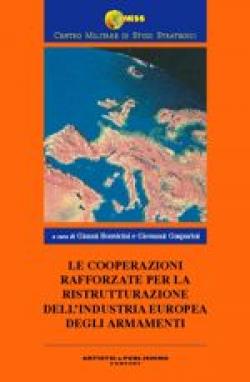Le cooperazioni rafforzate per la ristrutturazione dell'industria europea degli armamenti

Il recente Trattato di Nizza non ha aiutato a sgombrare il campo dagli equivoci che ancora circondano la politica di difesa dell’Unione. Non solo la Pesd rimane essenzialmente intergovernativa, ma è stata soprattutto esclusa la possibilità di applicare alla difesa il meccanismo delle “cooperazioni rafforzate” (art. 27B). Come risolvere quindi il problema di una maggiore trasparenza ed efficacia decisionale in mancanza sia di meccanismi di cooperazione rafforzata sia di voto a maggioranza qualificata come succede per la gran parte delle materie comunitarie? È un dibattito molto difficile che ruota attorno al senso che si vuole dare alla formula dei paesi “able and willing”. Di fronte a queste domande e alla vigilia di una ulteriore revisione del Trattato da varare entro il 2004 è opportuno approfondire il tema di una possibile estensione di un meccanismo ad hoc di cooperazione rafforzata anche al campo della politica degli armamenti. Questo libro dibatte approfonditamente questi temi, avvalendosi della collaborazione di tre esperti stranieri della materia, che con il loro contributo di pensiero hanno delineato le linee entro cui va inquadrata la problematica e offerto delle possibili soluzioni.
Volume preparato dall'Istituto Affari Internazionali (IAI) per il Centro militare di studi strategici (CeMiSS).
Introduzione
Le cooperazioni rafforzate in ambito difesa e le problematiche industriali: alcune proposte, Gianni Bonvicini e Giovanni Gasparini, p. 13-26
1. Le cooperazioni rafforzate in ambito difesa
2. Le problematiche industriali
3. Alcune proposte
The application of the concept of enhanced cooperation to CFSP/ESDP and arms industry, Mathias Jopp and Udo Diedrichs, p. 27-87
1. Flexibility, differentiation, enhanced cooperation – lines of argumentation
2. Models of flexible integration: Emu and Schengen
3. Closer cooperation from Amsterdam to Nice
3.1. The debate on closer cooperation at the IGC 1996/97
3.2. The decisions taken at Amsterdam: a general review
3.3. Closer cooperation in the first and third pillars
4. Enhanced cooperation in the treaty of Nice
5. The discussion about flexibility after Nice
6. Effects of possible extension of flexibility and enhanced cooperation to CFSP/ESDP and the field of defence industry
6.1. Flexible forms of cooperation in CFSP and ESDP: recent developments
6.2. The case of defence industry: demand for European solutions
6.3. Defence industrial cooperation: fragmentation and need for efficiency
6.4. Options for reforming the treaties
6.4.1. Flexibility outside the treaties: ad-hoc coalitions and core Europe?
6.4.2. Flexibility inside the treaties: core groups or multi-tier Europe?
6.4.2.1. CFSP/ESDP and defence industrial cooperation as a case of pre-determined flexibility inside the treaties
6.4.2.2. Cooperation in CFSP/ESDP and defence industry based upon a general enabling clause in treaties
6.4.3. Managing flexibility in CFSP/ESDP and defence industry
Bibliography
The current states of European cooperation in the field of armaments, Andrew D. James, p. 89-140
1. Introduction
2. European supply-side collaboration and consolidation
2.1. The growing importance of transnational defence companies (TDCs)
2.2. Industrial joint ventures
2.3. Government-to-government equipment programmes
3. The need for reform
3.1. Customer consolidation has lagged industrial consolidation
3.2. Reform is necessary for the competitiveness of the European defence industry
3.3. The need to increase customer purchasing power in the face of TDCs
3.4. Europe needs to make more efficient use of its defence spending
3.5. The CESDP requires closer armaments cooperation
4. Calls for reform
4.1. Calls for action at the European level
4.2. The European Commission Action Plan
4.3. The START 21 Report
4.4. The European Constitutional Convention
5. Current arrangements for armaments cooperation
5.1. WEAG
5.2. OCCAR
5.3. The LoI framework agreement
5.4. The European Union
6. Strengths and weaknesses of current European cooperative arrangements
6.1. Strengths of current arrangements
6.2. Weaknesses of current arrangements
7. The prospects for the reform of article 296 and the creation of a single market
7.1. What would be the benefits of a common market?
7.2. Article 296 and the constraints on Commission action
7.3. The prospects for reform of Article 296
8. What are the options for the future?
8.1. Institutional status quo
8.2. An increased role for Pillar Two of the European Union under established institutional arrangements and competences
8.3. An E.U. armaments market and policy based on the principle of enhanced cooperation
9. Conclusions



